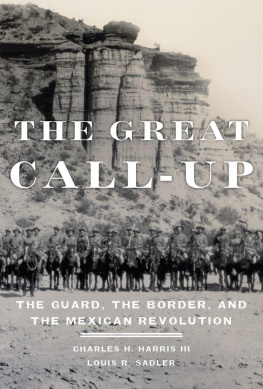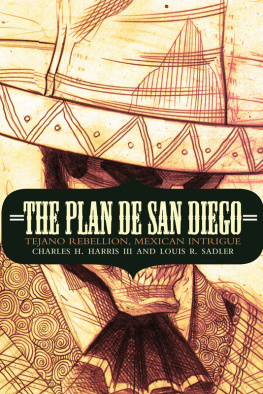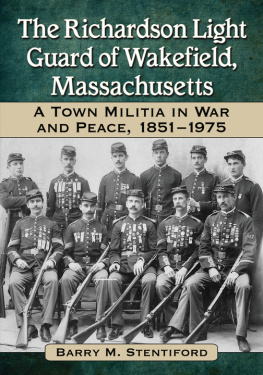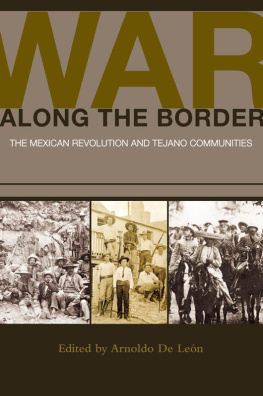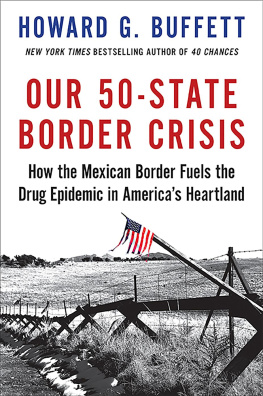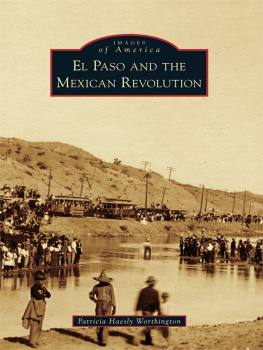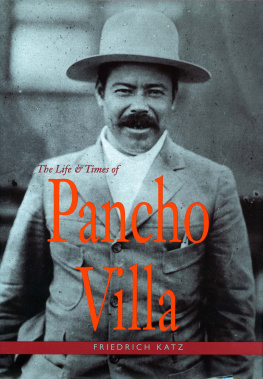
Major General Frederick Funston, commander of the Southern Department, the key figure in the National Guard call-up and border service. Courtesy of the Kansas State Historical Society.
THE GREAT CALL-UP
The Guard, the Border, and the Mexican Revolution
Charles H. Harris III and Louis R. Sadler
University of Oklahoma Press
Norman

2800 Venture Drive
Norman, Oklahoma 73069
www.oupress.com
Copyright 2015 by the University of Oklahoma Press, Norman, Publishing Division of the University. Manufactured in the U.S.A.
All rights reserved. No part of this publication may be reproduced, stored in a retrieval system, or transmitted, in any form or by any means, electronic, mechanical, photocopying, recording, or otherwiseexcept as permitted under Section 107 or 108 of the United States Copyright Actwithout the prior permission of the University of Oklahoma Press.
For information about permission to reproduce selections from this book, write to Permissions, University of Oklahoma Press, 2800 Venture Drive, Norman, Oklahoma 73069 or email .
ISBN 978-0-8061-4645-4 (hardcover : alk. paper)
ISBN 978-0-8061-4952-3 (ebook : mobipocket)
ISBN 978-0-8061-4953-0 (ebook : epub)
This eBook was converted from the original source file by a third-party vendor. Readers who notice any formatting, textual, or readability issues are encouraged to contact the publisher at .
To Colonel Leonid E. Kondratiuk
Contents
Illustrations
TABLE
MAPS
Acknowledgments
This book would not have been possible without the generous assistance we received from a number of institutions and individuals. Realizing the formidable research challenge we faced, we wrote to the adjutants general of the states requesting their assistance, and we received a gratifying amount of cooperation, whether from adjutants general themselves or from those to whom the adjutants general referred us. In addition, the personnel of various museums and historical societies went out of their way to support our endeavors, as did a number of librarians. To each of them we express our heartfelt thanks: Colonel Leonid E. Kondratiuk, director of Historical Services, Massachusetts National Guard Military Museum and Archives; Jim Gandy, assistant librarian/archivist, New York State Military Museum; 2nd Lieutenant Michael Anthony Rodriquez, historian, Public Affairs Office, California National Guard; Brigadier General James A. Adkins, adjutant general of Maryland; Captain Wayde R. Minam, command historian, Maryland National Guard; Joseph Balkoski, historian, Maryland National Guard; 1st Lieutenant Andy Thaggard, command historian, Mississippi National Guard; Darla Brock, archivist, Tennessee State Library and Archives; Michael W. Vogt, curator, Iowa Gold Star Military Museum; Gregory A. Moore, command historian, Florida National Guard; Steve C. Rucker, director, Arkansas National Guard Museum; Master Sergeant Brian J. Faltinson, command historian, Wisconsin Army National Guard; Staff Sergeant Joshua Mann, command historian, Ohio Army National Guard; Captain Chris Borders, Idaho Army National Guard; Mark Reaves, information specialist, State of Vermont Public Records; Richard N. Campbell, state military personnel officer, Utah National Guard; Deidre Forster and Bob Holmes, Wyoming Army National Guard; Staff Sergeant Rita Tompkins, out of service records manager, Maine Army National Guard; Janet E. Roberts, Maine State Archives; Anthony Douin, archivist, Maine State Archives; Master Sergeant David R. Glidden, support service supervisor, Maine Army National Guard; Colonel Warren W. Aney, Oregon Army National Guard historian; Sergeant Gail E. Parnelle, History Office, Georgia National Guard; Wendy Goen, archivist, Arizona State Library; Lisa G. Sharik, deputy director, Texas Military Forces Museum; Rita Sanchez, executive assistant to the adjutant general of Texas; Donaly E. Brice, senior archivist, Texas State Library; John Anderson, photo archivist, Texas State Library; William B. Boehm, historian, National Guard Bureau; Cathleen Pearl, archivist, National Guard Association; Mark Millorn, colleague and computer whiz, New Mexico State University; Major Lori L. Hampa-Chamberlin, Montana National Guard; Tom Graham, historian, New Hampshire National Guard; Jim Hurst, historian, Las Cruces, New Mexico; Lieutenant Colonel Bob Vrana, public affairs officer, Nebraska National Guard; John Trowbridge, command historian, Kentucky National Guard; Lieutenant Colonel James B. McCabe, command historian, Illinois National Guard; Captain Tamara Spicer, public affairs officer, Missouri National Guard; Joseph G. Bilby, assistant curator, National Guard Militia Museum of New Jersey; Staff Sergeant Claudia L. Bullard, command historian, Oklahoma National Guard; Lori Pribble, assistant to the Oklahoma adjutant general; Major Scott Bell, South Carolina National Guard historian; Major General Steven R. Doohen, adjutant general of South Dakota; Mary Schaff, librarian, Washington State Library; Robert R. and Jean Gates, photo archivists, Texas Military Forces Museum; C. Sigrid Maitrejean and Teresa Leal, Pimera Alta Historical Society; Jivonna Stewart, librarian, New Mexico State University; Rosemary Loa, librarian, Corpus Christi Public Library; Amber Korb, librarian and archivist, California State Military Museum; E. G. Buddy Sturgis, Jr., director, South Carolina Military Museum; Don Williamson, archivist, Luna County Historical Society; Sergeant Roberto Digiovine, South Carolina Army National Guard; Rebekah Tabah, photo archivist and curator, Arizona Historical Society at Papago Park; Phyllis Kinnison, archivist, Museum of South Texas History; Nancy Sherbert, acquisitions archivist, Kansas State Historical Society; Tracy Thoennes, curator, Kathleen M. Daly, museum technician, and Brigadier General James B. Thayer, Oregon Military Museum; Laura Hoff, archivist, Arizona State Historical Society; Matthew T. Reitzel, archivist, South Dakota State Archives; Shane Thomas, New Mexico State University, provided photographic assistance.
If we have inadvertently omitted anyone, we sincerely apologize. We thank our wives for their considerable assistance on this project and for putting up with us.
Introduction
The Mexican border has become the topic of increasing concern and controversy in recent years. The current debate over border security takes place against a background of National Guard involvement. President George W. Bush in 2006, in Operation Jump Start, ordered 2,000 guardsmen to the border to deal with a peaceful invasionthe thousands of people flooding across the international boundary from Mexico, most of them in search of a better life. And in 2010, President Barack Obama ordered 1,200 guardsmen to the border to reinforce the 340 guard members already supporting the Border Patrol. But the National Guards connection with the Mexican border did not begin just in the twenty-first century.
President Woodrow Wilson on June 18, 1916, took the unprecedented step of calling into federal service virtually the entire army National Guard of some 150,000 men to meet an armed threat from Mexico. Raids covertly sponsored by the Mexican government into the lower Rio Grande valley of Texas precipitated the call-up. About 110,000 guardsmen were rushed to the border as rapidly as rail transportation could be arranged.
This great peacetime mobilization has been neglected by historians for two reasons. First, it has been confused with the Punitive Expedition into Mexico led by General John J. Pershing against the Mexican revolutionary chieftain General Francisco Pancho Villa, who raided the New Mexico border hamlet of Columbus on March 9, 1916. The raiders killed eighteen soldiers and civilians and burned part of the town. Although President Pershing and his men remained in Mexico until February 5, 1917. Their presence obviously precipitated a crisis in United States-Mexican relations. While the Punitive Expedition was able to defeat Pancho Villas guerrillas, the real problem was Mexican president Venustiano Carranzas regulars, with whom the Punitive Expedition clashed on several occasions, one of them bringing the countries close to war.
Next page
